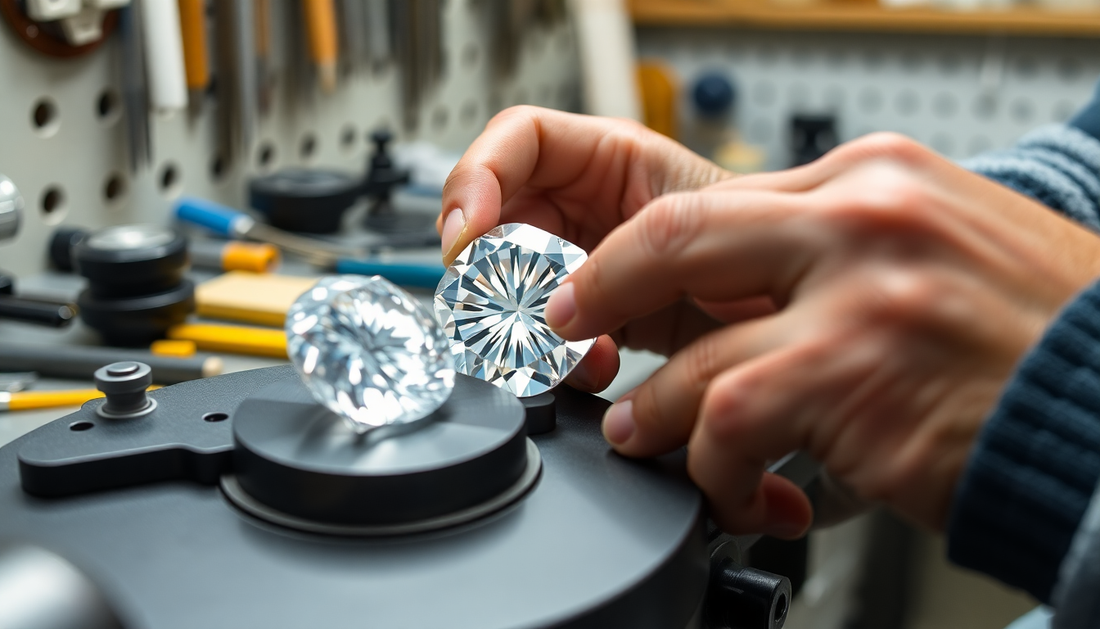
The Importance of Laps in Faceting: Unlocking the Beauty of Gemstones
Share
Faceting is the art of transforming raw gemstones into captivating, brilliantly-cut masterpieces. At the heart of this intricate process lies the use of laps, specialized tools that play a crucial role in shaping and polishing the gemstone's surfaces. In this comprehensive blog post, we'll delve into the significance of laps in faceting, exploring their various types, their function, and how they contribute to the creation of truly stunning gemstones.
Understanding Laps: The Faceter's Essential Tools
Laps are the foundation upon which the faceting process is built. These circular discs, typically made of metal or resin, serve as the platform upon which the gemstone is held and polished. Laps come in a variety of materials, each with its own unique properties and applications, catering to the diverse needs of faceters.
Metal Laps
Metal laps, such as those made of cast iron or copper, are renowned for their durability and ability to maintain a consistent, flat surface. These laps are often used for the initial stages of faceting, where the gemstone's rough form is transformed into a more refined shape. The hardness of metal laps allows for efficient material removal, making them ideal for the coarser stages of the process.
Resin Laps
Resin laps, on the other hand, are softer and more pliable, making them well-suited for the final stages of faceting. These laps are typically impregnated with abrasive particles, such as diamond or cerium oxide, which help to create a smooth, polished surface on the gemstone. Resin laps are particularly useful for delicate gemstones, as they can gently remove the final layers of material without risking damage to the stone.
Specialized Laps
In addition to the standard metal and resin laps, there are also specialized laps designed for specific purposes. These include:
- Tin laps: Ideal for polishing softer gemstones like topaz and citrine
- Tin-lead laps: Offer a balance of hardness and softness, suitable for a wide range of gemstones
- Wooden laps: Provide a gentler polishing action, making them useful for fragile or brittle stones
The choice of lap depends on the characteristics of the gemstone being faceted, the stage of the process, and the desired outcome.
The Role of Laps in Faceting
Laps play a crucial role in the faceting process, serving as the foundation upon which the gemstone's surfaces are shaped and polished. Each stage of faceting, from the initial cutting to the final polishing, requires the use of specific laps to achieve the desired result.
Cutting and Shaping
In the initial stages of faceting, the gemstone is placed on a coarse metal lap, such as cast iron or copper. These laps, with their flat and consistent surfaces, allow the faceter to efficiently remove material and shape the gemstone into the desired form. This process involves the use of specialized tools, such as dops and index wheels, to precisely control the angles and proportions of the facets.
Prepolishing
Once the basic shape of the gemstone has been established, the faceter moves on to the prepolishing stage. This involves the use of finer-grit laps, often made of resin, to smooth out the surfaces and remove any remaining imperfections. The softer nature of resin laps allows for a more delicate and controlled removal of material, ensuring that the gemstone's surfaces are prepared for the final polishing stage.
Polishing
The final stage of faceting is the polishing process, where the gemstone's surfaces are brought to a high-gloss finish. This is typically done using resin laps impregnated with fine abrasive particles, such as diamond or cerium oxide. The gentle, yet effective, polishing action of these laps helps to create the brilliant, reflective surfaces that are the hallmark of a well-faceted gemstone.
Throughout the faceting process, the faceter must carefully select and maintain the appropriate laps to ensure the best possible outcome. Proper lap selection and maintenance are crucial to achieving the desired level of precision, symmetry, and brilliance in the finished gemstone.
The Art of Lap Maintenance
Maintaining the condition of laps is essential for consistent and high-quality faceting results. Over time, laps can become worn, uneven, or contaminated, which can negatively impact the faceting process. Faceters must regularly clean, dress, and true their laps to ensure they remain in optimal condition.
Cleaning Laps
Regularly cleaning laps is crucial to prevent the buildup of debris and contaminants, which can affect the polishing process. This is typically done by using a lap cleaning stick or a soft cloth to remove any accumulated material from the lap's surface.
Dressing Laps
Dressing refers to the process of restoring the lap's surface to a flat, even condition. This is particularly important for metal laps, which can become uneven or develop grooves over time. Dressing is typically done using a dressing stick, which is a tool with a flat, abrasive surface that is used to grind down the high spots on the lap.
Truing Laps
Truing is the process of ensuring that the lap's surface is perfectly flat and parallel to the faceting machine's axis. This is crucial for maintaining the accuracy and consistency of the faceting process. Truing is typically done using a dial indicator or a precision straight edge, which is used to measure the flatness of the lap's surface.
By regularly maintaining their laps, faceters can ensure that their faceting process remains consistent and efficient, resulting in the creation of truly stunning gemstones.
Conclusion
Laps are the unsung heroes of the faceting world, playing a vital role in transforming raw gemstones into captivating works of art. From the initial cutting and shaping to the final polishing, the careful selection and maintenance of laps are essential for achieving the desired level of precision, symmetry, and brilliance in the finished gemstone.
By understanding the various types of laps, their specific functions, and the importance of proper lap maintenance, faceters can unlock the full potential of their gemstones, creating truly remarkable and awe-inspiring pieces that will be cherished for generations to come.